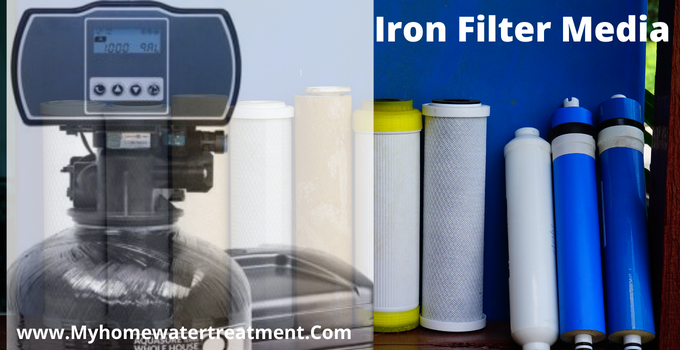No matter how efficient the direct iron removal system is that you use, it is always useful to have an additional water softener. Such a machine can render valuable assistance in dealing with well water problems. Well water treatment usually includes a number of measures. Among them is iron removal.

While you can use iron filters to remove the iron from your well water, these are expensive to install and maintain. Not to mention that some iron filters use a lot of electricity. Instead of going through all this additional expense, you could add water softener to your well water.
Not only will this cost less than an iron filter, but it will also help you remove the hard water. When looking for a water softener for your well water, there are a few things you should consider first.
In this article we are going to focus on the cheapest way to remove iron from well water.
Table of Contents
Why does the water have an iron?

Iron is a common impurity in water. The most common source of iron in drinking water is leaching from pipes and plumbing fixtures, especially if you live in an older home. Other sources of iron can be natural clay or rock deposits and fertilizers.
Iron may cause discolored water, but it doesn’t pose any health risks. Iron isn’t poisonous and it won’t make you sick. You can remove iron from your water with a simple filter or by boiling it for 15 minutes, which will help remove the taste of the iron as well.
The water in your house has iron because of old pipes and plumbing. This can be a problem for some people with sensitive skin, who may notice that they have an itchy red rash after taking a shower.
The reason these rashes happen is that the iron in the water combines with other elements in your skin cells to form rust. The resulting scabs are very itchy, and can even bleed if they’re scratched too vigorously.
If your water has high levels of iron, you may want to look into getting new plumbing installed in your home.
If you don’t want to spend money on this kind of project, you can try using a filter on your faucet or showerhead that will remove the excess iron from your water supply before it reaches your skin.
Iron is a common element in Earth’s crust and mantle. It occurs naturally in an oxidized state (Fe2+) or as iron (II) ions.
The oxidation number +2 is the most common for iron in minerals, although +1 and +3 also occur. Iron is present in many types of minerals including hematite, magnetite, goethite, limonite and siderite.
The red color of the water comes from dissolved iron. As a result of its high density (relative to water), iron will precipitate out of solution when it becomes enriched in a reducing environment. This process is known as “rusting” or “Ferro cyanide precipitation”.
Reducing environments include organic material such as decaying leaves that have fallen into the river, or algae growing on rocks in the stream bed. In addition to changing its color, this process also changes the taste of water.
What is the Science behind Iron in Water?
Iron is an essential mineral that the body needs, but it is also one that can be toxic if you get too much of it.
The human body has a difficult time excreting excess iron and can lead to serious health issues. The problem with iron in water is that it can cause stains on your clothes and fixtures, as well as rust buildup in your water pipes.
The presence of iron in water can be caused by several factors:
- Iron naturally occurs in rocks, soil and groundwater.
- Water treatment plants may use sand filters to remove impurities from drinking water, which can leave trace amounts of iron behind.
- Iron pipes used for plumbing can leach into your home’s water supply over time.

The science behind iron in water has to do with the chemistry of iron. Iron is a metal, and like all metals, it is not soluble in water. However, it can be oxidized by air and dissolved in water.
The oxidation process begins when iron reacts with oxygen in the air to form ferric oxide (FeO). This reaction happens naturally in the atmosphere as well as on surfaces exposed to air. When this happens in water, it forms ferric hydroxide (Fe (OH)3), which is also insoluble in water.
Because this insoluble compound forms on the surface of the metal or other object exposed to air, it will often be found there after rinsing off excess dirt or grime that would otherwise contaminate your drinking water supply.
The amount of iron dissolved depends on how much oxygen is available for the reaction and how much time has passed before you use your water for drinking or cooking purposes.
How to Choose a Water Softener for Well Water?
If you’re living in an area with well water, then you know that it can be hard to find the right water softener. Well water comes with many challenges, but there are also some advantages.
For example, if you have a well, then there is no chance of your tap water being contaminated by lead or other heavy metals that can cause health problems.
However, well water has its disadvantages as well. It usually contains high levels of iron and minerals that can make your hair feel dry and brittle. It may also have a high concentration of magnesium, which can create mineral deposits on your pipes and appliances.
If you want to reduce these problems without spending thousands on bottled drinking water every month, then it’s time to start looking for a good water softener for well water! Here are some tips on how to choose the best one:

Consider Your Water Usage Needs:
One thing that most people don’t think about when buying a new appliance is how much they will use it in the future. For example, if you only use your washing machine once per week but need softened water every day, then it might not make sense.
There are two main types of softeners: salt-based and resin-based. Salt-based softeners use salt as an ion exchange medium and resin-based utilize beads filled with sodium polyacrylate as an ion exchange medium.
How does a water softener work?
A water softener is a device that removes the hardness minerals from your water supply by replacing them with sodium ions. The softened water passes through filters before it enters your home plumbing system.
Water softeners work by using resins that are ion exchange resins made up of sodium ions (Na+) and chloride ions (Cl -).
When these resins come into contact with hard water, they replace the calcium and magnesium ions with sodium ions. The resin bed then releases the sodium ions when they come into contact with hard water again in your home plumbing system.
Moreover, a water softener works by removing magnesium and calcium ions from the water. These ions make the water “hard”, which makes it difficult for soap or detergent to lather properly when washing dishes or bathing.
They also leave behind mineral deposits that can clog pipes over time. A softener will remove these minerals from your home’s supply of H2O so that you don’t have to deal with them anymore!
What Is an Iron Filter and How Does It Work?
An iron filter is a water treatment system that removes excess iron from your water. You may have heard of this kind of system before, but you may not know exactly how it works.
Iron filters usually consist of three parts: a tank, a filter and a pump. The tank stores the water before it goes through the filter. The pump sends the water through the filter and then back into the tank where it’s ready to use.
The main thing that makes an iron filter different from other types of water filters is that it also removes sediment from your drinking water as well as any other contaminants that might be present in your local water supply.
Plus, it doesn’t take up much space and can be installed with minimal effort so you don’t have to hire someone else to do it for you!
Iron filters typically include an air pump that draws the water through the media bed, although some models use gravity instead of air pressure. The media bed may also contain activated carbon to remove organic compounds.
Advantages of iron filters
The main advantage of using an iron filter is that it can reduce levels of iron in your drinking water below what’s considered safe by the U.S. Environmental Protection Agency (EPA) or Food and Drug Administration (FDA).
This can help prevent discoloration and bad taste in your drinking water, as well as reduce its corrosivity so it’s less likely to damage pipes and appliances.
Top 6 Best Ways to Remove Iron from Well Water

Iron in well water is a common problem in many areas. Iron is a metal that will stain your clothes and can be dangerous to your health. The good news is that it’s fairly easy to remove iron from your well water. Here are the top 6 ways to remove iron from well water.
Chlorination
Chlorination is one of the most common and effective ways to remove iron from well water. To chlorinate your well, you’ll need chlorine bleach (5% solution), a bucket or other container with a lid, gloves, and a rubber band to hold the lid down tight on the bucket.
You’ll also need a hose connected to either an outdoor spigot or an indoor faucet near the well so you can get access to running water.
Mix half a cup of bleach with one gallon of cold tap water in a five-gallon bucket or other container with a lid that’s big enough for you to submerge the end of your garden hose into it.
Place the end of your garden hose into this mixture and secure it tightly with a rubber band so that no air bubbles can escape from inside the bucket while it’s sitting on top of your well casing or pump housing, then leave it there overnight.
A water softener is one of the most effective ways to remove iron from well water. A water softener uses sodium chloride or other salts to exchange the hardness minerals in your water for sodium ions and chloride ions.
The resulting softened water flows through your plumbing system until it meets up with hard water again — at which point the process repeats itself. This cycle continues until all of the hardness minerals have been removed from your well water supply.
Ion Exchange Resin
An ion exchange resin works by removing dissolved iron particles from your well water supply by exchanging them with positively charged sodium ions that are held within its structure.
As this process occurs, negatively charged chloride ions are released into your well’s plumbing system as a result of their electrostatic attraction to positive charges on the ion exchange resin’s surface area.
This means that you should expect to see some color changes when using an ion exchange resin treatment system for iron removal purposes.
Aeration Based Iron Removel System

Aeration is one of the most effective ways to remove iron from well water because it uses oxidation to neutralize the pH levels in your well water. It also increases oxygen levels which helps fight off bacteria and parasites that may be living in your well.
This method works by injecting air into your well through an aerator pump or by using an air stone in your pump house. This allows oxygen from the air to enter into your well and convert any iron present into harmless rust particles that can be filtered out by sand filters or other types of filters.
Use a reverse osmosis system

Also Read:10 Best Reverse Osmosis Systems
A reverse osmosis filter consists of two chambers: one holds clean water while the other holds concentrated brine waste (saltwater).
The concentrated brine waste pushes fresh water through semi-permeable membranes that trap impurities like iron and manganese while allowing fresh water to pass through into another chamber for use by your home’s plumbing system.
Conventional Ways to Remove Iron from Well Water
Home Remedies
Some people claim that adding citrus fruits or vinegar to the water will remove iron from well water. However, this method does not work.
Also Read: How To Remove Salts From The Water
Other homemade solutions include placing aluminum foil in the water tank and letting it sit for a few days or boiling the water until it begins to turn brownish-red. Neither of these methods works effectively because they do not remove all of the iron from your well water.
Commercial Products
There are several commercial products on the market that can help remove iron from well water. One such product is called FerroChrome™, which is available at hardware stores and home improvement centers.
You simply add this product to your tank at a rate of 1 ounce per gallon of water and let it sit overnight before using it again as usual. This product can be used every two weeks until you no longer see any color in your water coming out of your faucet or shower head.
Top 10 Best cheapes ways to Remove Iron from Well Water
Lime Softening
Lime softening involves adding calcium hydroxide (also known as “lime”) to your water supply to help remove hardness minerals like iron and magnesium from your system.
This method removes both dissolved minerals and suspended particles from your water supply, making it an effective way to remove both iron and rust stains caused by these minerals from your home’s fixtures.
Liming does have some drawbacks though, including high upfront costs and difficulty getting rid of excess lime once it has been added.
Distillation
Distillation is a process in which water is boiled and the steam is collected and condensed back into liquid form.
The distillation process works by boiling the water until pure steam forms, which can be collected and condensed back into water again. The remaining impurities in the water are left behind as residue when you remove the steam from your container.
Activated Alumina Filters
Activated alumina filters are known as “soft” filters and work by absorbing some of the impurities found in water, such as iron, even at low concentrations. These filters can be installed right above your faucet or under your sink so that they’re easy to use whenever you need them!
Reverse Osmosis Filters

Our readers get 5% off at springwellwater.com – 👉 Use Code MHWT5
Reverse osmosis filters are considered “medium” filters because they require electricity to operate properly but can remove more than just iron from your drinking water supply! They’re also easy to install right above your sink faucet so that cleaning them out isn’t a hassle either!
Filtration
A filter is a good way to remove small amounts of iron from your well water without having to boil it first or add chemicals that may harm your health or the environment.
A reverse osmosis system is an effective method of filtering out most minerals and metals, including iron and manganese, but these systems can be expensive and require regular maintenance in order for them to work properly over time.
Boiling
Boiling water is the most common way to remove iron from well water. Boiling removes the oxygen from the water, so it can no longer react with the iron particles.
The remaining iron particles will settle on the bottom of the pot, where they can be easily scooped out. The disadvantage to this method is that it requires a lot of time and energy. You’ll need to boil your water for several hours before it becomes clear again.
Adding bleach
Adding bleach to your well water can help remove some of the iron in your well water. The bleach reacts with the iron particles in much the same way as boiling does – by removing oxygen from around them so they cannot react any further with other substances in your well water.
You should add one capful of bleach per gallon of water that you want to treat and let it sit overnight before drinking or using it for any other purpose.
Oxidizing agents
Oxidizing agents like potassium permanganate can oxidize iron into a form that can be filtered out by settling tanks or filtration units. However, this process is slow and doesn’t always work completely — especially if there is a lot of iron in your well water supply.
Iron Filter Media

Iron filters are an affordable solution to remove iron from well water. They can be installed on a faucet or in-line with your plumbing system at the point of use, such as under the sink or in the shower.
Iron filters use a chemical reaction to bind with iron in your water and then oxidize it into harmless compounds. To remove iron from well water, you can purchase a commercial-grade filter that uses an active ingredient like potassium permanganate or hydrogen peroxide (H2O2).
These active ingredients are generally safe for human consumption but may have side effects if they come into contact with skin or eyes.
You should always wear gloves and safety glasses when handling these chemicals and avoid breathing their fumes, which can irritate the lungs if inhaled directly from the container.
Add Vinegar
Adding vinegar to your washing machine when washing clothes helps remove some of the staining caused by iron in well water. Simply add one cup of vinegar per load during wash cycles.
Vinegar also helps loosen mineral deposits that may be causing problems with plumbing fixtures like faucets or shower heads.
Conclusion
You need to know that iron removal in your water will not simply make your water smell and taste better, it will also improve its quality.
You need a whole house water filtration system for iron and other heavy metals, but the ones mentioned above are relatively cheap and good enough to get the job done.
There are many methods to remove iron from well water. This article covers the chemistry behind iron removal, as well as 10 different methods. This article has informed you about the cheapest way to remove iron from well water.
Iron filters are useful for removing iron from well water, but they can be somewhat pricey to set up. Now that you know the basics of how these filters work and why they are worth considering, you may get lucky and find an old water softener system at a garage sale. Good luck and happy filtering!